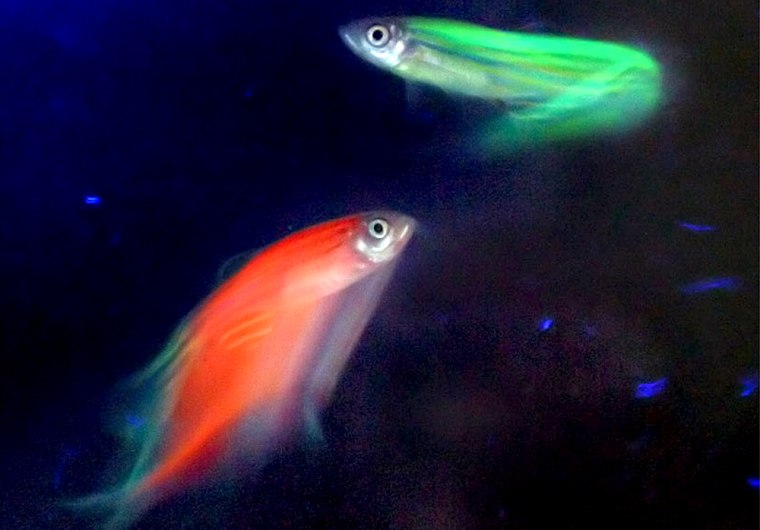Old-timers will remember a song made famous by the Mills Brothers in the 1950s called "Glow Worm." The song has since become a staple of elementary school music courses in North America, where children sing, "Glow little glow worm, glow.” Are there really worms that glow? Yup. Is this a bad thing? No. But some creatures that don’t normally glow are about to start doing so and that should raise some ethical eyebrows.
A biotechnology company in Austin, Texas has given the little glow worm a shiny new rival. Yorktown Technologies has started selling a limited number of genetically engineered aquarium fish that glow in the dark. The company says these critters will be available nationwide Jan. 5.
The genetically engineered fish is a zebra fish that has a gene found not in a worm but in a kind of coral. The company can snip the "glow gene" out of the coral and stick it into the genes of a zebra fish embryo. This produces an animal that will definitely get your neighbors talking about your aquarium.
So who cares? Why should these newly created shiny occupants of fish tanks cause us to worry?
Who's keeping an eye on the fish?
The problem is that the fish that live in aquariums sometimes do not stay there. They wind up going down the drain or toilet when we or the kids get tired of them. And that means releasing into the environment a new kind of fish without any guarantee of what will happen once they get out there.

Alan Blake, chief executive of Yorktown, says the company has checked with the Food and Drug Administration, the Environmental Protection Agency, the Department of Agriculture and the Fish and Wildlife Service but all of them say they are not responsible for keeping a safety eye out for the new kind of fish. The FDA did say on Dec. 9 that it saw no reason to worry about any special danger to the food supply from GloFish, because tropical aquarium fish are not used for food purposes. Well, perhaps except by some slightly tipsy male college students.
The chances are this glowing new product of biotechnology won’t pose a threat to anyone or anything. Still one state, California, has decided that the uncertainties are great enough to ban GloFish sales. The fact is that in the rest of the country and in other nations a new fish is about to hit pet stores without any clear regulatory check or systematic safety assessment. And that is exactly what is wrong with how we are dealing with biotechnology.
Regulatory agencies not keeping pace
Scientists and companies keep tweaking our plants and animals and even our pets but our regulatory agencies are not keeping pace. We don’t have adequate rules about how to release genetically engineered plants and animals into the environment. Businesses still introduce new plants, seeds and animals without making adequate information available to the public about what they are or where they are. And no single federal agency has responsibility for assuring the safety of genetically engineered plants and animals.
The glowing fish are shedding some light on an important problem. We don’t have sufficient oversight in place to make sure that the new animals and plants that result from genetic engineering are really safe for us and the environment. We need Congress to assign clear responsibility for genetically engineered plants and animals to one federal agency. And that agency needs to make sure that the rules for release and standards of safety glow brightly for both business and the public.
Arthur Caplan is director of the Center for Bioethics at the University of Pennsylvania.
